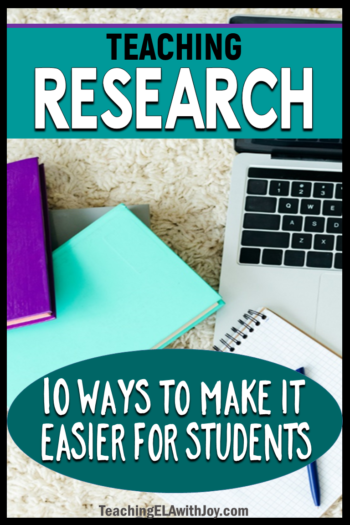
I enjoy diving into research units with my students because they get to learn new things, and I do, too! But teaching research skills is a gigantic task! And one thing’s for certain: I’ll have to break the research process into steps to keep my middle school students from feeling overwhelmed. I want them to have that “I’ve got this” attitude from the moment I introduce the project.
Of course, as teachers, we need to be prepared and have our research assignments clearly-designed. But a big key to making the process easier for me and my students, what makes the most impact I think, is modeling. If you can model what you want students to do (as opposed to just telling them), your expectations become clearer. Not everything can be modeled, but whenever the opportunity arises, it’s powerful!
Here are 10 ideas to make teaching research skills manageable and successful:
1. Make sure students start out with more than one topic option. What I mean is, it helps for each student to have “back up” topics ready to go in case the first choice isn’t panning out. For example, I’ve had students who chose a topic they were very passionate about. But it turned out that once they got searching, not enough information was turning up. In most cases, these students had decided to research very current topics like a YouTuber or a new version of iPhone or even a specific automobile. They searched and searched, but the few sites they located just repeated the same smattering of facts. It REALLY helped that the assignment required three topic choices, with students prioritizing their choices. Instead of getting all stressed out, the students just went with their second choice, and got right into note-taking. Or let’s say you are assigning topics, for example, for Holocaust research. Once they start researching, students may find a certain topic too complex and would feel more supported if they had other options.
On this organizer, students brainstorm three topic choices and then prioritize their choices: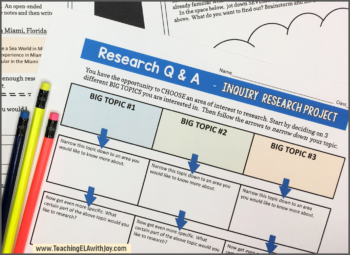
2. Don’t rule out books and other print sources. Now that so many students carry laptops, we’ve come to expect research to be Internet-based. Of course, there’s nothing wrong with that! With just a few clicks, students have access to SO MUCH information. But some of my students come and ask if they can go to the library for printed sources because they prefer taking notes from books. That reminds me that we all learn differently. It might be to our amazement, but library research is alive and well for a portion of our students. Sometimes it’s my struggling learners who go for the printed sources, but I’ve also had more advanced learners hit the books as well. Even if you’ve got kids on their laptops or in the computer lab, find a way to incorporate different types of sources in their search so you differentiate. FYI, the Common Core Standards for W.8 (the research writing) state “Gather information from multiple print and digital sources . . .” So, it looks like using some print sources is still an expectation (but not for every assignment) if you follow Common Core. Definitely let your librarian in on whatever type of research assignment you have going on. They’re usually very eager to provide support!
3. Emphasize the need to narrow search terms. So often, students just want to plop their main topic into the Google search bar, right? Unfortunately, what comes up is usually current information that is not necessarily going to hit what they need. That’s how time gets wasted. You can quickly model this skill for students with an example using a celebrity. Say you are needing information on a certain celebrity’s life—some facts about their rise to fame. Place just the name in the search bar, and what most likely comes up are articles that have been in the news about the person. Then place the name with the word “biography” in the search bar and have students notice the difference.
4. Explain the connection between research and reading. Once they have a topic, students are so ready to start note-taking! But wait, do your students understand that research starts with careful reading? First, they’ll need to preview several websites before taking any notes. I call it “Ten Minutes, Reading Only.” That’s the least they can do to look for sources that not only match their topic but meet their readability needs. Let’s face it, many websites or even printed sources are written well above some of our students’ reading levels. Let them know that if they are finding long sentences with numerous unfamiliar words, it’s time to move on. Then, once they do locate a few good sources, they still need to read! When they come upon information they understand that really hits the topic, BINGO. That’s when note-taking should begin.
5. Model note-taking using a bulleted list of short phrases. One thing is for sure: we don’t want students to copy full sentences, word for word, when they take notes. So modeling this when you’re teaching research skills is huge. I always tell students that they will create their own complete sentences when they are drafting. Note-taking is for short phrases. Just give them a heads up that they have to be able to understand the shortened information! I’ve had students who wrote phrases too short for the complex information they represented. A problem arose, of course, when trying to draft sentences. The students couldn’t remember what was actually meant by the few words they had copied down.
You can easily model note-taking by choosing a paragraph of nonfiction from a website or online encyclopedia. Project it on your whiteboard or pass out copies to the class. You can have students work with a partner to take notes in short phrases on a bulleted list. Students could then exchange papers several times to see what others came up with, and then share out what they noticed. Or, you may prefer to make the notes on your whiteboard with whole-class participation.
6. Show students the citation generator you want them to use and how it works. Teaching research skills always includes citing sources. So if you approve of students having citations created for them, I’m with you! Just be clear on which citation generator to use. I’ve always preferred www.Bibme.org, but now with all the ads on these sites, and Google Docs’ own generator, there are other options. Again, you can do a quick modeling on your Smartboard using a website. It’s a good idea to walk around during note-taking and check that each student is comfortable using the citation generator. Sometimes students are unsure but might not want to ask.
7. Offer creative formats for students to use as their research product. If you can, let them infuse some of their own passion into the topic. Let’s face it, teaching research skills is easier when students are personally invested. Your standards or district curriculum may require a research-based essay, and that’s fine. With lots of scaffolds and modeling, the results can be awesome! But how about having students report out in a newsletter format? They can break the information down into four short articles and give each one a title. Now the assignment becomes more motivating. Or require a slide presentation, with a paragraph of text on each slide along with visuals.
Another creative format is a Q & A page. My students enjoy a short project called Research Q & A, where they choose a topic they’d like to learn more about and create two questions to research. They report their findings on a Q & A sheet, using a template they type into, along with visuals.
8. Have students color code their notes. This is an incredibly helpful scaffold to producing an organized draft! Once the research is completed, students should look over their notes and on a sheet of paper, list the “sub-topics” they have covered. For example, if they are writing an informational article about an athlete, their list might include childhood, training, early career steps, and best achievements. Then, with 4-5 colored pencils, they underline each sub-topic with a different color. Students then read through their notes, placing a colored bullet to match as they find content corresponding to the sub-topic.
The color coding helps make drafting each paragraph so much easier! Students just focus on all the green information on their notes pages when drafting the first body paragraph, all the purple information when drafting the second, etc.
9. Require editing and revising using a different color. As English teachers, we want the revising and editing step to be meaningful. When revisions stand out this way, both students and the teacher get to visibly see a growth process. They understand that they are expected to and can notice weaknesses and make their product better. I always keep red and green pens available. And I sense that kids like using them. Another BIG plus here: individual conferencing becomes quick and easy when you can see by the colored ink which revisions have (or have not!) been made.
10. Work in some peer exchange opportunities. Students benefit from regular check-ins, but you don’t always have the time. So why not have students check in on each other? Decide on a few times in your assignment when students will need to “take stock” of things. That’s when you’ll say, exchange with a partner, and look at x, y, or z. The check can be as simple as the partners write feedback in the margin of each other’s paper, or on a post-it, or have a short discussion. For example, let’s say you allot two periods for research, and you expect three solid pages of notes. When the second class period is drawing to a close, have a partner exchange. Peers have two tasks: rate the quality of the notes on a scale of 1-5 and suggest whether note-taking is complete or more needs to be done as homework.
Students love to read each other’s papers, so work in a peer exchange during revising and editing. Have peers place a question mark in the margin next to any area that doesn’t make clear sense. You could also choose a couple specific topics for their focus, such as capital letters and commas. Students enjoy these roles and checks like these build skills and confidence.
Our goal, of course, is to make research motivating for every one of our students. By using some of these strategies, teaching research skills should become easier! I think your students will experience excitement over all the new learning their efforts bring.
I’ve developed some print-and-go research activities that students enjoy and have success with. They include step-by-step scaffolds and mentor texts to save you time. Just click on the images to have a closer look.

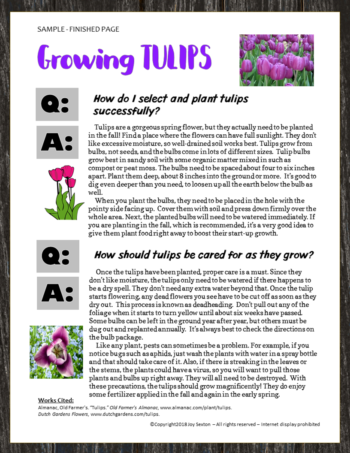

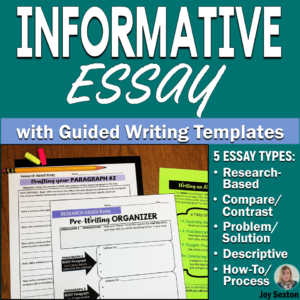
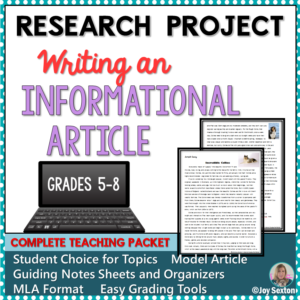
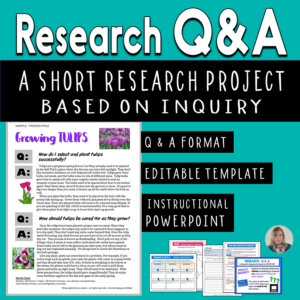
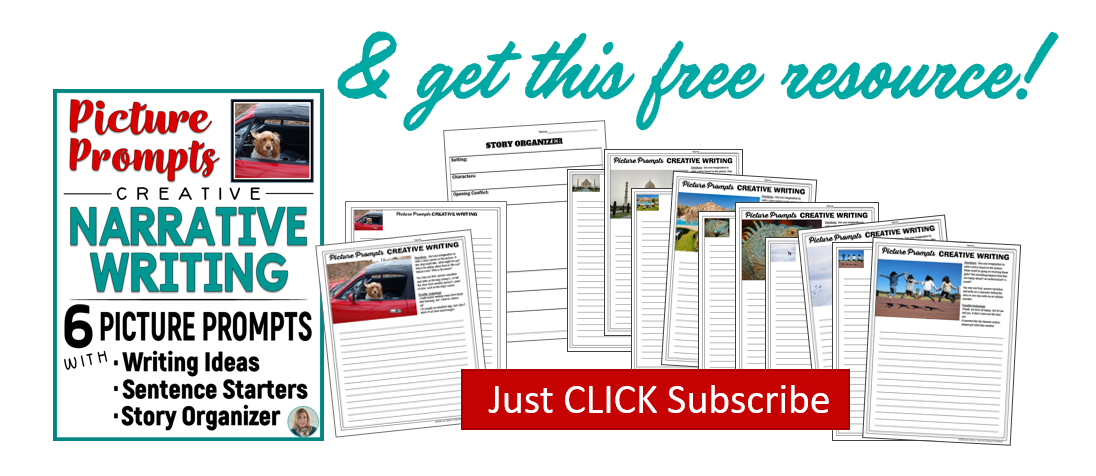


This looks amazing. I’m so glad I found this article. I am guiding my 7th grader through a year-end research project at home and this is exactly what I needed to help guide me through it first!